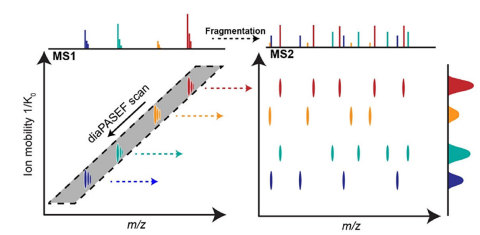Bruker Announces Major Advances in CCS-Enabled 4D Proteomics at ASMS
Bruker Corporation (Nasdaq: BRKR) announced major advancements in its mass spectrometry capabilities at the 69th ASMS meeting in Philadelphia. The new CCS-enabled technologies for the timsTOF Pro 2, timsTOF fleX, and timsTOF SCP systems enhance proteomics workflows with rapid, high-sensitivity analysis. Key features include the identification of over 8,000 cell lysate proteins, a new OligoQuest software for RNA analysis, and the SCiLS autopilot for automated mass spectrometry imaging. These innovations aim to improve proteomics research, particularly in cancer biology and therapeutic development.
- Introduction of CCS-enabled technologies enhancing proteomic workflows.
- Ability to quantify over 8,000 cell lysate proteins with efficient gradients.
- Launch of OligoQuest software for RNA characterization.
- SCiLS autopilot automates mass spectrometry imaging, improving accessibility.
- None.
Insights
Analyzing...
-
Bruker PaSER™ software now incorporates transformative CCS-enabled DIA-NN deep neural network learning with breakthrough dia-PASEF capabilities to identify:
- >8000 quantified cell lysate proteins with 40-minute gradients
- >5000 quantified cell lysate proteins with 4.8-minute separations on Evosep One
- >5000 quantified proteins in just 10 ng of cell lysate digest with 95-minute gradients
- Work-in-progress CCS-enabled ‘prm Live’ on timsTOF Pro enables low-cost, targeted proteomics with >1800 peptides quantified with highest sensitivity and excellent CVs
- Advances in CCS-enabled TIMScore™ algorithm yield significantly greater phosphopeptide and protein coverage with more confident peptide identifications
- Novel OligoQuest™ software and workflow for high confidence sequence verification in support of RNA and modified oligonucleotide therapeutics development
- SCiLS™ autopilot software for automated Mass Spectrometry Imaging (MSI) acquisition on the timsTOF fleX and rapifleX® MALDI platforms using Bruker IntelliSlides™
-
Showcasing two novel systems launched already in
June 2021 :- timsTOF SCP for unbiased single cell proteomics (SCP), e.g., to study cell-type specific proteomes in spatial cancer biology and correlate them with sc-RNA-seq transcriptomes
- next-generation timsTOF Pro 2 with unprecedented proteomic depth and throughput

Graphical representation of dia-PASEF scan function (Graphic: Business Wire)
Dr.
A. PaSER powered by CCS-enabled DIA-NN for dia-PASEF workflows
Translational proteomics, requiring high-throughput, short gradients and uncompromised proteome depth is achieved using dia-PASEF, published in Nature Methods [Mann,
In collaboration with Drs.
Dr.
B. prm-PASEF Live increases number of targeted peptides for high-sensitivity quantification
prm-PASEF workflows for parallelization of targeted compound acquisition maintains very high sensitivity while targeting more compounds than traditional PRM approaches. A new prm-PASEF editor can now be used independently or when Skyline™ is used to create prm methods. A recent paper by Professor
C. TIMScore for CCS-enabled database search engines
CCS values in 4D-Proteomics applications are used in post processing for ‘match between runs’ for label-free quantitation [Cox, MCP 2020]. TIMScore now harnesses machine learning for a CCS-enabled algorithm enabling search engines to provide greater peptide and protein identification while retaining stringent false discovery rates (FDR). Hundreds of thousands of experimental data points were used to train a ML algorithm that can accurately predict CCS value of tryptic and phosphorylated peptides. Phosphorylation plays a critical role in cell signaling and biology, but phosphorylated peptides are more difficult to identify. TIMScore increased the number of phosphorylated peptides by >
Professor
D. Launch of OligoQuest™
Bruker’s new OligoQuest software in the GLP-ready BioPharma Compass suite offers enhanced RNA and oligonucleotide characterization. OligoQuest leverages high isotopic fidelity from maXis II and timsTOF Pro to characterize nucleic acid macromolecules, such as single-guide RNA as well as their impurities. Furthermore, fast PASEF acquisition maps complex mixtures derived from digested mRNA samples.
Co-developed with
E. SCiLS autopilot for automating MALDI Mass Spectrometry Imaging (MSI)
Bruker introduces the automated setup of MALDI Imaging with SCiLS™ autopilot enabled by IntelliSlides™. SCiLS autopilot automatically conducts six key performance optimizations to quickly move from a prepared slide to acquisition of data. The scanned sample image is registered with on the barcode on the IntelliSlide, tissue margins are automatically detected, followed by automated multi-step optimization to decrease the time and expertise needed for MALDI Imaging, and to ensure reproducibility and image quality. Through SCiLS autopilot automation, MALDI Imaging can be easily integrated by non-expert users to add physiological tissue context to their 4D-
Dr.
References:
[Mann, Nat Methods 2020]: https://doi.org/10.1038/s41592-020-00998-0
[Demichev, Nat Methods. 2020]: https://dx.doi.org/
[Demichev, bioRxiv 2021]: https://doi.org/10.1101/2021.03.08.434385
[Cox, MCP 2020]: https://doi.org/10.1074/mcp.tir119.001720
[Marto, Anal. Chem. 2021]: https://doi.org/10.1021/acs.analchem.1c02349
About
Bruker is enabling scientists to make breakthrough discoveries and develop new applications that improve the quality of human life. Bruker’s high performance scientific instruments and high value analytical and diagnostic solutions enable scientists to explore life and materials at molecular, cellular and microscopic levels. In close cooperation with our customers, Bruker is enabling innovation, improved productivity and customer success in life science molecular and cell biology research, in applied and pharma applications, in microscopy and nanoanalysis, as well as in industrial applications. Bruker offers differentiated, high-value life science and diagnostics systems and solutions in preclinical imaging, clinical phenomics research, proteomics and multiomics, spatial and single-cell biology, functional structural and condensate biology, as well as in clinical microbiology and molecular diagnostics. Please visit www.bruker.com.
View source version on businesswire.com: https://www.businesswire.com/news/home/20211102005437/en/
Media Contact
T: +49 (421) 2205-2843
E: petra.scheffer@bruker.com
Investor Relations Contact
T: +1 (978) 663–3660, ext. 1479
E: Investor.Relations@bruker.com
Source:







